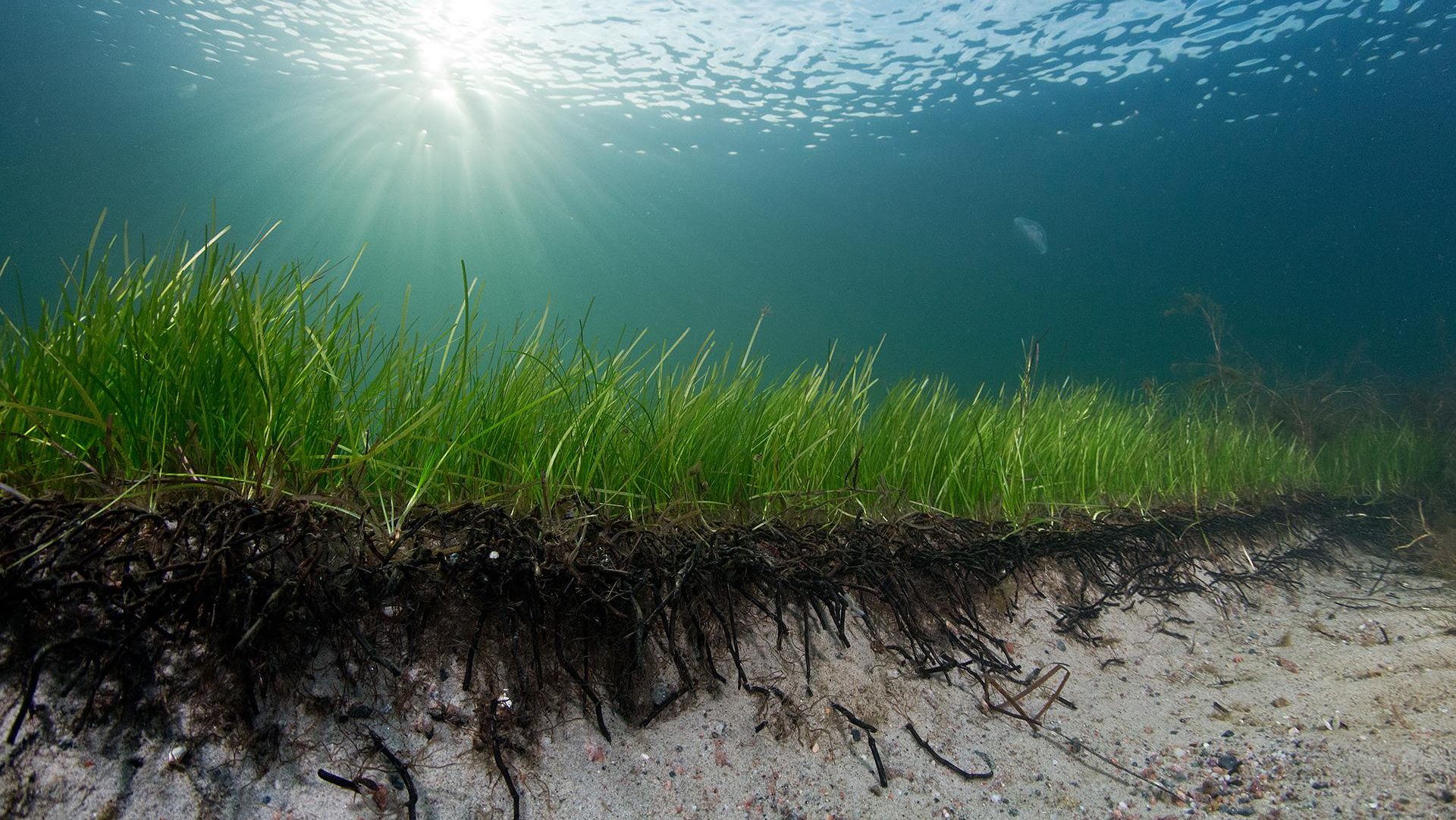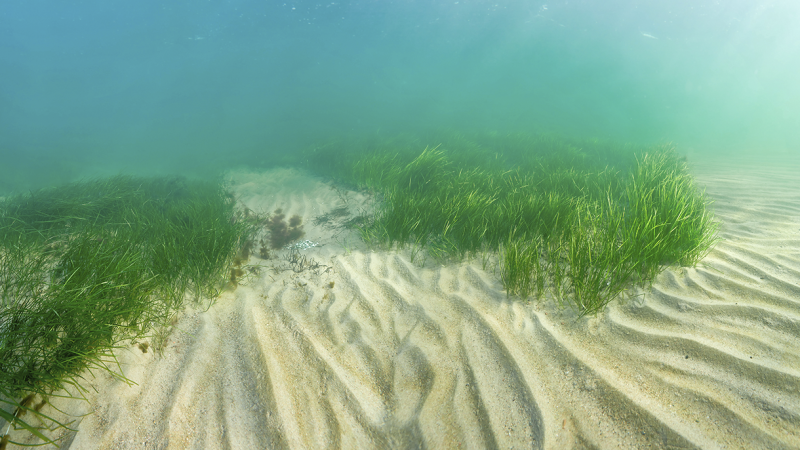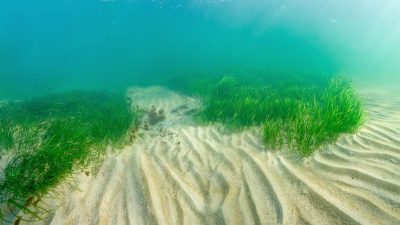Baltic Seagrass project
In the Baltic Seagrass Project, we are working with the Metsähallitus’s Parks & Wildlife Finland unit to restore seagrass meadows, formed by common eelgrass – one of the key species in the Baltic Sea. The meadows will be restored by transplanting common eelgrass seedlings to places where the plant has once grown but has since disappeared. Common eelgrass provides a habitat for dozens of other species in the Baltic Sea. By restoring the seagrass meadows, we are combating nature loss in the Baltic Sea. In this project, we are also joining forces with Central European marine conservation foundations to increase people’s awareness of marine nature and biodiversity.

Common eelgrass forms dense meadows on the seabed. Photo: Pekka Tuuri
More information:

What is common eelgrass?
- Common eelgrass is a key species in the Baltic Sea. It forms extensive and dense seabed meadows that teem with life, just like coral reefs. Common eelgrass meadows provide food and shelter for dozens of species in the Baltic Sea. The roots of these dense meadows bind bottom sediment, which reduces erosion and turbidity. Water quality improves too, as the meadows bind nutrients contained in the water.
- Common eelgrass thrives on sandy bottoms and uses its roots to spread over large areas. A variety of gastropods and crustaceans graze in these meadows – which also provide food and shelter to many fish in the Baltic Sea.
- Common eelgrass meadows are effective carbon sinks. However, in the northern Baltic Sea, these meadows sequester less carbon than in the southern Baltic Sea, where natural conditions for the growth of this plant are more favourable.
Common eelgrass is in danger of disappearing
In the Baltic Sea, common eelgrass meadows have declined as a result of coastal construction and seabed dredging, for instance. However, the meadows have suffered the worst from marine eutrophication: in turbid water, not enough light reaches plants growing on the seabed. Proliferating filamentous algae have also claimed living space from common eelgrass – these fast-growing algae can spread over perennial common eelgrass meadows and smother them. In fact, common eelgrass seabeds are currently classified as Near Threatened habitats. However, marine eutrophication has been mitigated in some parts of our coasts, giving common eelgrass meadows an opportunity to recover.
In the Baltic Seagrass project, we are working with the Parks & Wildlife Finland unit of Metsähallitus to restore common eelgrass meadows in areas where it has previously grown, but has since disappeared from. Common eelgrass does not spread by means of seeds in the northern Baltic Sea – planting is carried out by collecting a small number of seedlings from thriving lush meadows and then planting them in suitable, unoccupied sandy seabeds. The goal is that these seedlings will grow to form extensive new common eelgrass meadows.
Encouraging results from previous plantings
In recent years, Metsähallitus’s marine nature conservation team has piloted the transplanting of common eelgrass in state conservation areas in the western Gulf of Finland. Monitoring results indicate that these plantings have been successful, and common eelgrass has formed dense new vegetation at some sites. Plantings have been carried out on a larger scale in Sweden and Denmark.
In recent years, underwater nature surveys on Finland’s coast have yielded plenty of information on existing meadows and seabed areas suitable for the common eelgrass, some of which are known to have once been home to eelgrass. The Baltic Seagrass project selects planting areas in cooperation with Metsähallitus’s Parks & Wildlife Finland unit on the basis of existing survey data.
Restoring biodiversity outside protected areas
The new plantings made in the Baltic Seagrass project will mainly be located outside state conservation areas. This will help to expand the seabed habitat network and restore marine biodiversity in new areas. The John Nurminen Foundation will be responsible for carrying out the plantings with the support of Metsähallitus’s Parks & Wildlife Finland unit. Metsähallitus will also monitor the newly planted meadows.
Marine nature restoration supports the objectives of the EU’s biodiversity strategy, the EU Nature Restoration Law and the 2022 United Nations Biodiversity Conference (COP 15), which seek to conserve and restore 30 per cent of marine nature by 2030.
Promoting marine nature through international cooperation
Meadows formed by common eelgrass and other seagrasses are important habitats not only in the Baltic Sea, but also the other seas of the world. Seagrass meadows are some of the most diverse habitats in the sea and also serve as significant carbon sinks, helping to combat climate change. Over the past 40 years, as many as a third of the world’s seagrass meadows have disappeared.
In the Baltic Seagrass project, our Foundation will start international cooperation with two continental European marine protection foundations. This cooperation seeks to implement concrete marine nature projects and promote marine nature protection by increasing people’s awareness of marine nature’s current state and the importance of its biodiversity to us human beings, too.

What is seagrass?
Seagrasses are the only flowering plants that live in salty seawater. They adapted to marine life back in the era of the dinosaurs, 100 million years ago. About 60 different species of seagrass live in the world’s seas. Only one of them thrives in the northern, low-salinity Baltic Sea – the common eelgrass (Zostera marina). Seagrass meadows only cover 0.1 per cent of the bottoms of the oceans, but nevertheless account for as much as 11 per cent of marine carbon sequestration. These meadows are unbeatable carbon sinks – in terms of carbon stored per area, even more effective than tropical rainforests! Seagrass meadow habitats sustain diverse life around them, including numerous fish stocks on ocean coasts. This also makes them vital for people living by the sea.
